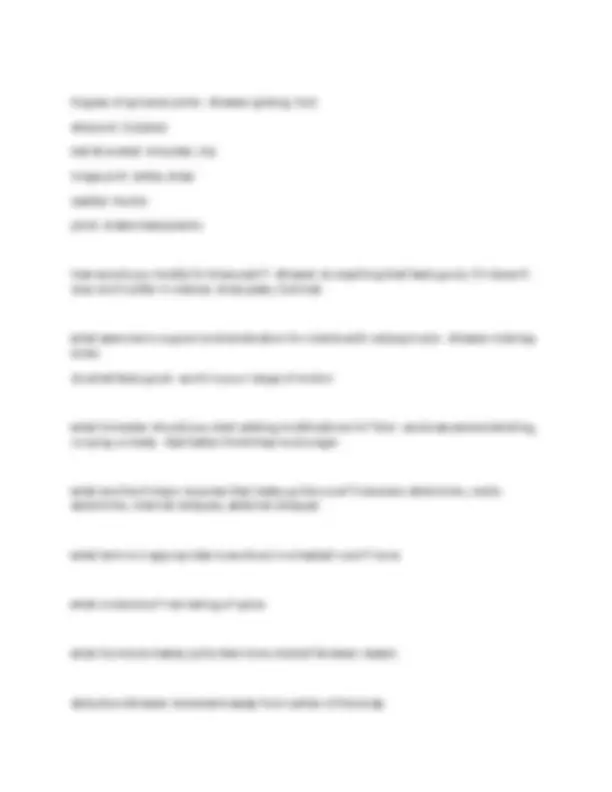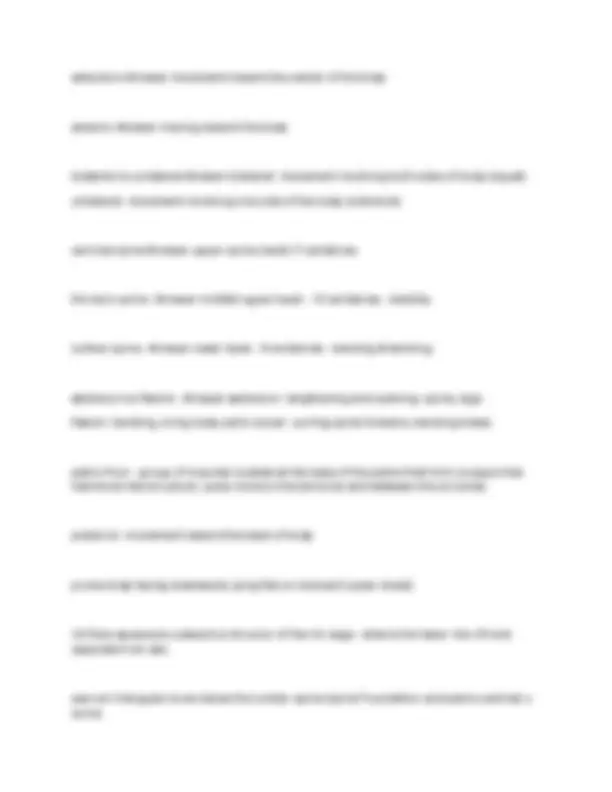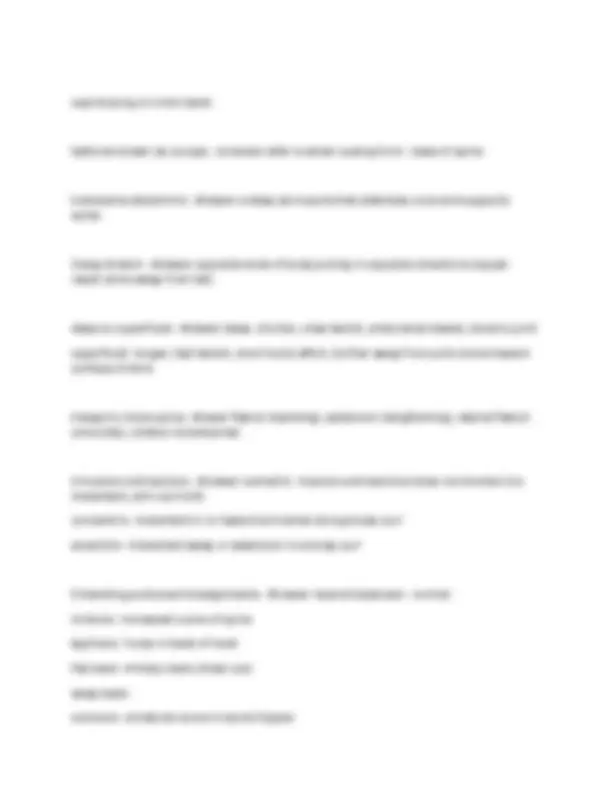





Study with the several resources on Docsity

Earn points by helping other students or get them with a premium plan


Prepare for your exams
Study with the several resources on Docsity

Earn points to download
Earn points by helping other students or get them with a premium plan
Community
Ask the community for help and clear up your study doubts
Discover the best universities in your country according to Docsity users
Free resources
Download our free guides on studying techniques, anxiety management strategies, and thesis advice from Docsity tutors
A comprehensive set of questions and answers related to mat pilates, covering fundamental principles, movement techniques, and modifications. It explores key concepts such as the six pilates principles (breath, concentration, control, centering, precision, flow) and ten movement principles, detailing their application in various exercises. The material also addresses specific conditions like diastasis recti, knee pain, osteoporosis, and scoliosis, offering tailored modifications to ensure safe and effective practice. Additionally, it covers anatomical aspects, including the muscles of the core, spinal movements, and joint types, making it a valuable resource for both instructors and practitioners seeking a deeper understanding of pilates. The document also includes information on working out during pregnancy and the use of props.
Typology: Exams
1 / 7

This page cannot be seen from the preview
Don't miss anything!




6 Pilates Principles - Answer breath, concentration, control, centering, precision, flow 10 Movement Principles - Answer breathing, core activation, neutral pelvis, abdominalstrength, lumbopelvic stability, spinal strength & mobility, scapular strength & mobility, posture & postural analysis, release work, stretching 4 types of breath - Answer lateral, sniff breath, one lung, belly breathing where was joseph pilates born - Answer Germany what american city to joseph tech in & in what year - Answer NYC 1926 difference between imprint and neutral spine - why is there a debate in the pilates world- Answer imprinting: pressing lower back into the mat (classical). neutral: natural spinal curve (contemporary). imprint helps decrease injury and pull incore "slight tuck, pull belly button in and up" what is powerhouse - Answer all of the muscles in the core - abdominal, lower back,glutes
what is pilates - Answer complete coordination of mind, body and spiritmovement that focuses on the 6 principles set of exercises that focuses on strengthening the core and mobilizing joints/spine
what is the difference between classical & contemporary - Answer classical: in order,specific reps, starts lying down modern contemporary: new version of repertoire, no set sequence, repetitions are doneas needed, can begin from supine or standing position
what 3 spine mobilizers - Answser rollout, rolle up, rolling like a ball pre pilates warm up: cat/cow, dog tail, bridging, figure 8 what is general modification for all exercises in series of 5 - Answser lowering of headneck and shoulders
when to inhale/exhale - Anwer inhale to prepare, exhale in movement lateral breath cue how do you cue - Answer pilates breath - inhale through noseexpanding ribs pulling belly button to spine, exhale through mouth closing rib cage
what prop do you want to have available when teaching high scissors or high bike? -Answer ball under hips
modification for open leg rocker - Answer bend legs, grab behind hamstrings variation of side kick - Answer up and down, rainbow, clamshell, circles, pulse what is diastasic recti? - Answer linea alba - separation of abdominal wall 4 ways to move spine? - Answer flexion: bending extension: lengthening lateral flexion: side kick, side lungerotation: transverse
adduction Answer movement toward the center of the body anterior Answer moving toward the body bilateral vs unilateral Answer bilateral: movement involving both sides of body (squat)unilateral: movement involving one side of the body (side kick)
cervical spine Answer upper spine (neck) 7 vertebrae thoracic spine - Answer middle/ upper back - 12 vertebrae - stability lumbar spine - Answer lower back - 5 vertebrae - bending & twisting extension vs flexion - Answer extension: lengthening and opening -spine, legsflexion: bending, bring body parts closer -curling spine forward, bending knees
pelvic floor - group of muscles located at the base of the pelvis that form a supportivehammock like structure. pubic bone to the tail bone and between the sit bones
posterior- movement toward the back of body prone-body facing downward, lying flat on stomach (open chest) rib flare excessive outward protrusion of the rib cage - where the lower ribs lift andseparate from abs
sacrum triangular bone below the lumbar spine (spine' foundation and pelvis central) ccurve
supine lying on one's back tailbone known as coccyx - bone we refer to when cueing form - base of spine transverse abdominis - Answer a deep ab muscle that stabilizes core and supportsspine
2 way stretch - Answer opposite ends of body pulling in opposite directions (squat -reach arms away from tail)
deep vs superficial - Answer deep: shorter, slow twitch, endurance based, close to joint superficial: longer, fast twitch, short burst effort, further away from joint (more towardsurface of skin)
4 ways to move spine - Anwer flexion (bending), extension (lengthening), lateral flexion(one side), rotation (transverse)
3 muscle contractions - Answer isometric: muscle contracts but does not shorten (nomovement, arm out hold) concentric: movement in or toward arm when doing bicep curl eccentric: movement away or extension in a bicep curl 6 standing postures/ misalignments - Answer neutral balanced - normal lordosis: increased curve of spinekyphosis: hump in back of neck flat back: military back (chest out) sway back:scoliosis: unnatural curve in spine 2 types
first trimester - Ansswer - visible changes minimal
3rd trimester- Belly & uterus rapidly growingIncreased forward tilt of pelvis Good exercises: squats, side lying leg lift Soft Ball- can increase stability or decrease stability, take pressure off spine and addresistance
magic circle - this can add resistance to increase muscle endurance, createsawareness of imbalances in body, helps connect with powerhouse, alignment is correct
ankle weights/ hand weights - increases stability, strength and control, makes exercisesmore challenging don't use when in c curve